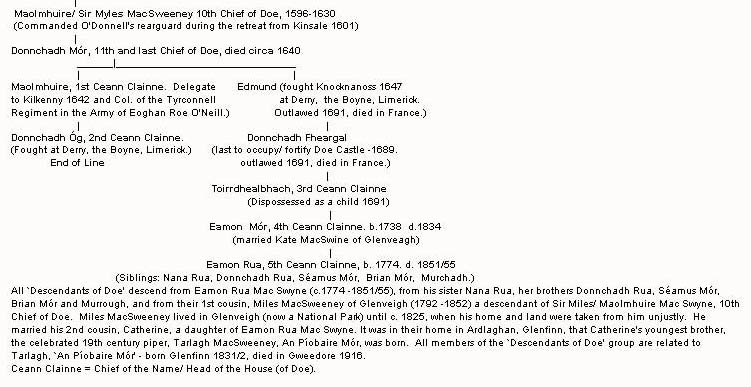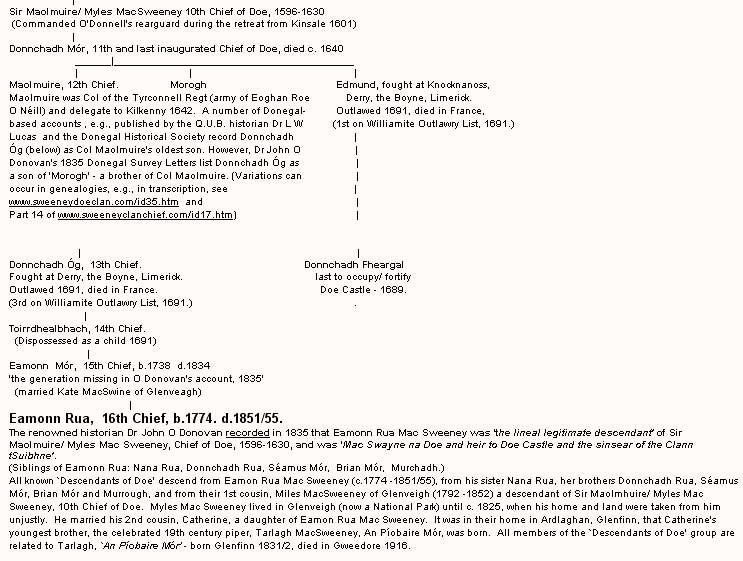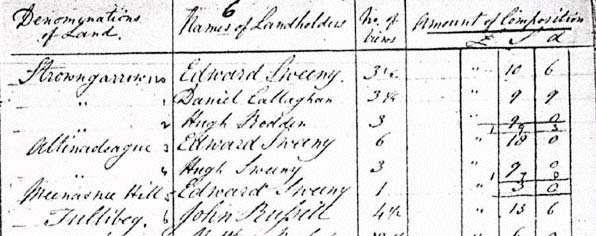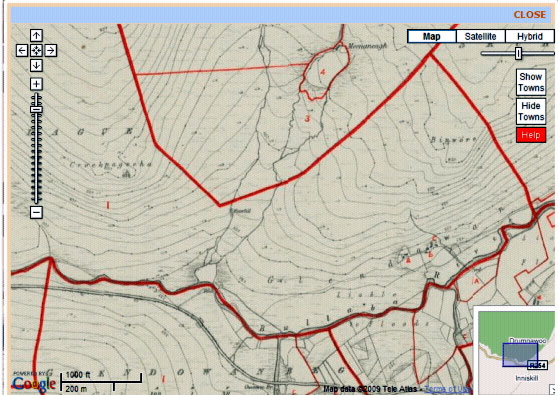| Irish Chiefs Back to Homepage |
Report on the Mac Sweeney Doe Chiefship
Summary: Thomas Sweeney lays claim to the chiefly title of Mac Sweeney Doe, asserting that he is the senior descendant of the last duly inaugurated chief. In 2003 his claim was validated by a prominent professional genealogist nominated by the Chief Herald of Ireland, but Mr Sweeney has persistently refused to release a full copy of her report or full particulars of the genealogical proofs stated to be contained therein. In response to the writer's queries and criticisms, Mr Sweeney altered his pedigree in 2005, tacitly conceding that the earlier and supposedly validated version was erroneous. Mr Sweeney continues to assert his claim to chiefship, alleging that the writer is unqualified to raise questions about the validity of his pedigree in any of its versions. The claimant has made a number of personal attacks against the writer in a repetitious tirade at http://www.sweeneyclanchief.com/id27.htm, including professional incompetence, plagiarism and much else. I had been endeavouring to deal with these false and constantly multiplying charges on a separate webpage, but I am no longer updating this and will rest my case on the present report.
Background Rival Clans Pedigree Alteration Oral Tradition and Documentation Conclusion
Background
The MacSweeneys were a County Donegal 'Galloglas' warrior sept which originated in Scotland, and historically there were three branches, Fanad, Doe and Banagh, each with its own chief. Collections of Gaelic pedigrees, conveniently gathered together by Rev Paul Walsh in Leabhar Chlainne Suibhne (Dublin 1920), furnish the lineages of the three main branches of the MacSweeneys until the mid to late seventeenth century. After this period the descent of the senior MacSweeney lines becomes obscure, as is the case with so many Gaelic families, so that the chiefships of Fanad, Doe and Banagh were generally deemed to have become dormant.
In modern times, two gentlemen, Loughlin Sweeney and Mingo Sweeney, have lain claim to the titles of Mac Sweeney Fanad and Mac Sweeney Banagh respectively, and it was also asserted that the late Marquis MacSwiney of Mashanaglass had been offered the title of Mac Sweeney Doe ('Resolution of the Grand Council of Clan Suibhne', 21 September 1979). The Fanad and Banagh claimants are generally considered to be clan-appointed or 'honorary' as opposed to genuine or 'bloodline' chieftains, this despite the fact that rather controversially they have purported to be able to transmit their titles to heirs by primogeniture. In recent years a claimant to the title of Mac Sweeney Doe has emerged, in the person of Thomas Sweeney, a retired public official who resides in Dublin and Donegal. Mr Sweeney claims to be a true bloodline chief, distinguishing himself from and indeed criticising the Fanad and Banagh claimants, and we now take the opportunity to examine the merits of his case. The author of the present independent report is a trained historian and experienced genealogist, a special research interest being tracing the lineages of claimants to Irish chiefships, and he is the author of a full-length scholarly study, Twilight of the Chiefs: The Mac Carthy Mór Hoax, Bethesda, Maryland, 2004.
Rival Clans
Mr Sweeney maintains two websites in which he endeavours to substantiate his claim to the Mac Sweeney Doe chiefship: http://www.sweeneydoeclan.com/ and http://www.sweeneyclanchief.com/. In particular, he stated that on 6 August 1999 the then Chief Herald of Ireland, Brendan O Donoghue, selected professional genealogist Máire Mac Conghail to verify his claim, and he gave quotations from her report dated 24 August 2003 which support the said claim: http://www.sweeneydoeclan.com/id28.htm. As of 6 September 2005 the names of the individuals in question (now members of the new Board of the National Library of Ireland), as well the quotations from the report mentioned, appeared to have been removed from Mr Sweeney's website. Further quasi-official approval of Thomas Sweeney's claim may be inferred by the presence on his website of a history of MacSweeney Doe by Chief Herald Fergus Gillespie (http://www.sweeneydoeclan.com/id25.htm), with quotations from correspondence of his also. Disregarding or perhaps unaware of the ramifications of the Office of the Chief Herald's role in validating the bogus chief Terence MacCarthy, others have chosen to consider Mr Sweeney to be confirmed in his chiefly status, for example, the author Anne Chambers, who has referred confidently to 'the validation of Thomas Sweeney's claim to the chieftaincy of Doe in 2003' (At Arm's Length: Aristocrats in the Republic of Ireland, New Island, Dublin 2004, page 6). Thomas Sweeney has also been closely assisted in his claim to chiefship by another author, Randal MacDonnell, who was active in the campaign to expose MacCarthy, but whose own claims to the titles of 'Count' and 'Mac Donnell of the Glens' have now been called in question (see our report).
Somewhat confusingly, there is also an 'Official Sweeney Clan' which while recognising the chiefly claims of both Loughlin Sweeney and Mingo Sweeney, does not recognise Thomas Sweeney and merely appoints a rotating 'honorary Chieftain of Doe'. Mr Sweeney served in this honorary capacity from 1995-99 (http://www.sweeneyclan.com/committe/earlydays.html), and here is how his involvement is presented by the 'Official Sweeney Clan':

Randal MacDonnell, styled Mac
Donnell of the Glens,
and Thomas Sweeney, styled Mac Sweeney Doe
(photograph courtesy Sunday Tribune)
Thomas Sweeney and his professional genealogist as quoted place great emphasis on a pedigree recorded by the scholar John O'Donovan in 1835, which was recited from memory by a claimant to the Mac Sweeney Doe chiefship he had encountered in the course of his work for the Ordnance Survey. The claimant, Edmond or Eamon, was a 'tinker by profession' but still proudly asserting chiefly lineage, and he provided O'Donovan with the following pedigree:
Sir Mulmurry
|
Donough More
|
Murrough
|
Donough Oge
|
Turlough
|
Edmond, aged 61 in 1835
(Annals of the Four Masters, 6, footnote page 2,341.)

Version of Mac Sweeney Doe pedigree in Tom Sweeney, 'From Doe to Derryveigh',
The Sweeneys: Fanad, Doe, Banagh, International, Gweedore 1997, page 106.
This version of the pedigree was replicated in Mr MacDonnell's 1999 report and continued to serve Mr Sweeney's purposes in the years following, being reproduced on his website in the following form:

Of course it is a staggering presumption to 'correct' O'Donovan's pedigree in this manner after a period of 170 years, adding and subtracting names at will in order to concoct a chiefly lineage. O'Donovan's comment about the pedigree probably being a generation short may be taken as an indication of at least a degree of scepticism concerning its reliability. Mr Sweeney's version of his family history also claimed that Donnchadh Fheargal, recorded as 'Denis Arigil' on the 1909 oral pedigree, was the 'last to occupy/fortify Doe Castle 1689', and that he had a son Toirrdhealbhach, 'dispossessed as a child 1691', whose descendants were restored as tenant farmers in Glendowan and Derryveigh only after Catholic Emancipation in 1829 ('From Doe to Derryveigh', pages 105-08). It was reasonable to ask to what extent this tale was actually proven, or could it have been based merely on supposition, family lore, and imaginative interpretation of sparse surviving documentation, allied perhaps with not a little invention?
In the face of these questions and criticisms, Mr Sweeney obviously found it inconvenient to continue to maintain the claims in the above version of his lineage, and so without any sort of apology or explanation, in October 2005 he altered his pedigree as follows:

Version of pedigree at http://www.sweeneydoeclan.com/id22.htm, February 2006
It can be seen that Mr Sweeney has disposed of a formerly claimed ancestor Donnchadh Fheargal, reorganising the pedigree to show descent from the latter's uncle Colonel Maolmhuire, whose line had formerly been stated to have ended. Of course the new version of the pedigree is no more valid than the old, and it differs from O'Donovan's 1835 pedigree in that the third name is altered from Murrough to Maolmhuire, and the additional Eamon remains tagged on at the end. This constant tweaking and alteration of pedigrees to achieve a desired result is of course entirely unacceptable, and must surely invalidate Mr Sweeney's claim to chiefship. Indeed, when the Office of the Chief Herald moved belatedly to withdraw recognition from the bogus chief Terence MacCarthy in July 1999, it presented as its primary justification for doing so the fact that he had altered the information on the basis of which his chiefship had originally been recognised (Statement of the Genealogical Office, August 1999, http://mccarthy.montana.com/MacCarthyMor/goaugust.html).
Yet another version of the alleged Mac Sweeney Doe pedigree made an appearance in September 2006:

It is obvious that this pedigree is even more contradictory and confusing than its predecessors, in that Donnchadh Oge, the '13th Chief', appears to be positioned ambiguously as the simultaneous son of three brothers, Maol Mhuire, Morogh and Edmund! And of course there is still no satisfactory evidence that Mr Sweeney descends from the said Donnchadh Oge, who is stated to have died in France. Mr Sweeney has also advanced the following remarkable explanation for his 'correction' of the latter part of O'Donovan's pedigree: 'Eamonn Rua had forgotten to include his father, Eamonn Mór, who died the previous year' (http://www.sweeneyclanchief.com/id27.htm). What is to be said of the reliability of an orally transmitted pedigree where the reciter fails to include his own father's name? No doubt a further version of the Mac Sweeney Doe pedigree could be produced with perhaps yet more 'variations', but at this stage any competent genealogist can see that the effort to prove descent from the last inaugurated chief has become a total shambles.
Oral Tradition and Documentation
What of oral tradition as proof of a given lineage or a claim to chiefship? The writer accepts that there is a long-standing tradition in Mr Sweeney's family of descent from the Chief Sir Maolmhuire MacSweeney. Yet many Irish families have similar traditions, for example, on the writer's maternal side there is a story of descent from the Wicklow Chief Fiach MacHugh O'Byrne, which he has been unable to validate and therefore could not advance as proven. Mr Sweeney also takes comfort from a Scottish 2004 court judgement in the MacDonald of Keppoch case which declares that a sloinneadh or orally transmitted pedigree should be accepted as valid evidence when determining succession to chiefship (see full text at http://www.sweeneyclanchief.com/id26.htm). While orally transmitted pedigrees can be useful guides in research, it flies in the face of good genealogical practice to accept them as conclusive proof of descent. Of course Scottish law relating to chiefship does not apply in Ireland, being in any case itself the subject of debate. Thus a standard Scottish legal textbook states that Lord Lyon 'has no jurisdiction to determine rights of precedence, nor to decide a disputed question of chiefship or chieftainship' (Gloag and Henderson, Introduction to the Laws of Scotland, Edinburgh 1980, page 22).
Mr Sweeney refers as well to an Irish Law Reform Commission report which states that 'family repute' and 'general repute' are legal evidence of pedigree, the inference being that an undocumented claim to chiefship such as his is supported in Irish law (http://www.sweeneydoeclan.com/id22.htm). The report in question appears to be the 'Report on the Rule Against Hearsay', 1978 (http://www.lawreform.ie/public
It may be relevant to point out that it is an important part of the ethic of the professional genealogist to claim no more than the evidence allows, a point made forcefully in the code of conduct of the US Board for Certification of Genealogists: 'I will not publish or publicize as fact anything I know to be false, doubtful, or unproven; nor will I be a party directly or indirectly, to such action by others' (http://www.bcgcertification.org/aboutbcg/code.html). Furthermore, the Board for Certification of Genealogists has decided to abandon the term 'preponderance of evidence', which refers to the standard of proof applying in civil trials, on the grounds that genealogy requires a level of proof higher than that applied by the judicial system in such cases (http://www.bcgcertification.org/resources/prepond.html). The Board now advocates a Genealogical Proof Standard (GPS) consisting of five principal elements: 'a reasonably exhaustive search; complete and accurate source citations; analysis and correlation of the collected information; resolution of any conflicting evidence; and a soundly reasoned, coherently written conclusion' (http://www.bcgcertification.org/resources/standard.html).
There are indeed other problems with the evidence adduced to connect O'Donovan's claimant Edmond with the family of the current claimant to the chiefship. As we have seen, O'Donovan's chief was described as a tinker living in the vicinity of Sheep Haven in 1835, whereas Thomas Sweeney's ancestors were tenant farmers living inland in the mountainous Derryveagh area. One pertinent record which raises difficulties for Mr Sweeney's case is the 1833 Tithe Applotment Book for Gartan Parish which lists an Edward Sweeney landholder in 'Altinadeague', illustrated below, and it is this apparently settled individual rather than the wandering Sheep Haven chiefly claimant who is more likely to be Thomas Sweeney's ancestor.

Edward and Hugh Sweeny, Altinadeague, Tithe Applotment Book, Parish Gartan, 1833
National Archives of Ireland, TAB 7/14, microfilm reel 29

Hugh, James and John Sweeney, Attinadague, Griffith's Valuation, 1858,
http://griffiths.askaboutireland.ie

Griffith's map showing houses of Hugh, James and John Sweeney, a, b, c, in Attinadague,
http://griffiths.askaboutireland.ie
It might be added that the Sweeneys of Attinadague were among those who fell victim to the notorious Adair evictions of 1861, when they were listed as follows:
James Sweeney, wife and eight children
Owen Sweeney, wife, mother and eight children
(Liam Dolan, Land War and Evictions in Derryveagh, Dundalk 1980, page 194.)
Alleging that the present writer is 'totally and utterly confused' in his interpretation of the available documentation, Mr Sweeney has woven a complicated tale whereby 'Eamon Óg' took a lease of land in Altnadague (Attinadague) in the 1830s, and then invited his father, the wandering 'Eamon Rua' encountered by O'Donovan in Sheep Haven, to join him, thus ending the 'long dispossession' suffered by the family since the late seventeenth century (for a version of this improbable yarn see http://www.sweeneydoeclan.com/id40.htm). No documentation is cited to prove a transition from traveller to settled farmer status, or a move from the vicinity of Sheep Haven to Derryveagh, and like much else in the claim, vague and malleable oral pedigrees and family traditions are all that are generally advanced. The surviving documentation is admittedly sparse, and it indicates nothing more than that the Sweeneys were settled in Attinadague from the 1830s until their eviction, with no indication of a chiefly lineage or connection with a wandering claimant to the title of Mac Sweeney Doe. Mr Sweeney is not interested in objective analysis of the available documentation, preferring instead to howl against the present writer's allegedly poor scholarship in the following inimitable style:

Of course, for all his bluster Mr Sweeney still has produced no evidence that the Edward Sweeny listed in the Tithe book was the son of or in any way related to the wandering chief 'Eamon Rua'.
I have endeavoured over a considerable period of time to clarify outstanding issues with Thomas Sweeney and his professional genealogist, and to secure a copy of the latter's report or at least clearly identified source citations, but without success. In response to the first version of the present commentary (posted 6 March 2005), Mr Sweeney revised a page of his website at http://www.sweeneydoeclan.com/id22.htm on 12 March 2005 and subsequently, but without adequately addressing the points raised. For example, his professional genealogist was quoted as stating that 'it is acknowledged' that the name of 'Eamonn Mór' is omitted from O'Donovan's pedigree, but of course this is more in the nature of a convenient assumption than an established fact. While the full text of the report in question has not been released, extracts were as indicated placed for a time on Mr Sweeney's website at the last cited location, including the following selected footnotes:
(Page 9, footnote 54) According to the article in the Weekly Irish Times Tarlagh recited Eamon as the father of Donogh/Denis.
(Page 9, footnote 55) Senior, translation of sinsear - head or chief.
(Page 9, footnote 56) In this recital Edward Mór - the father of 'Émon now the senior aged 61' is omitted.
(Page 9, footnote 57) Annala Rioghachta Éireann / Annals of the Kingdom of Ireland by the Four Masters, ed. John O'Donovan, (Dublin, 1856, 1990): 1603 Mac Suibhne na ttuath Maolmuire murchaidh ....
(Page 10, footnote 59) It is worth noting that in the oral traditions when it came to reciting, for example genealogies, omissions or variations could occur; similarly, omissions could have occurred in transcription.
(Page 10, footnote 60) Sinsear, head or chief of the Mac Suibhne na dTuath family or tribe.
The writer has to say that
he does not find these footnotes at all
rigorous in evidential terms, the special pleading in relation to
'omissions' underlines the essential weakness of the case, and the
removal of even extracts from Mr Sweeney's website cannot be said to
indicate complete confidence in the report's effectiveness. It is one
thing to point out that Gaelic pedigrees as recorded could
contain errors and omissions, which is indeed true, but quite another
to 'correct' received pedigrees
retrospectively in order to make them accord
with fanciful ideas of chiefly descent.
As Ms
Mac Conghail's report allegedly validating Mr Sweeney's claim was
completed in 2003, it is reasonable to believe that it would have
supported
the now abandoned version of the purported Mac Sweeney Doe pedigree,
and so its
release now might be a cause
of considerable embarrassment to all involved (had the report validated
another version of the pedigree, this would raise even more serious
questions). The writer e-mailed Ms Mac
Conghail on 10 October 2005, asking whether in the light of Mr
Sweeney's alteration of his pedigree she still stood over her report,
and if she would permit the release of the full text for the purpose of
fair comparison with my work. No reply has been received, and it would
not be unjust to conclude that the status of the report in question is,
to say the least, uncertain. To put it in plain terms, Mr Sweeney's
alteration of his pedigree was a tacit admission that the writer's
earlier
criticisms were well founded, and the newly substituted pedigree he now
advances in support of his claim to
chiefship is equally questionable.
Conclusion
Here is Mr
Sweeney's pedigree, in so far as it can be documented at present:
Altnadague, Co Donegal, alive 1833
|
James Sweeney
Altnadague and later Stramore, died 1883
|
Edward Sweeney
Stramore (Glendowan), died 1922
|
Hugh Sweeney, Civic Guard
Stramore, various postings and later Cornagullion, died 1970
|
Thomas Sweeney, the claimant
Born 1935 Manorhamilton, County Leitrim
Sources: Tithe Applotment Book, Parish Gartan, 1833, National Archives of Ireland; Griffith's Valuation and plot maps,
Parish Gartan, 1858, Irish Origins and Ask About Ireland; birth, marriage and death registrations, General Register Office;
Census of Ireland 1901 and 1911, National Archives of Ireland; Donegal Genealogy Resources.
It has been shown in the present report that Mr Thomas Sweeney's claim to the Mac Sweeney Doe Chiefship rests primarily on orally transmitted pedigrees and family tradition, rather than on documentation properly cited and analysed. As to the Mac Sweeney Doe chief John O'Donovan reported he had encountered in Donegal in 1835, in the absence of proper documentary evidence no competent genealogist would assert more than that O'Donovan's candidate was a claimant rather than an attested chief, one of many who then as now have populated the island. Mr Sweeney cites the authority of John O'Donovan in support of his own claim to chiefship, but he has several times altered the pedigree recorded by this scholar in order to attach his family, and the ludicrous result of these manipulations is shown above. It has been pointed out as well that while O'Donovan's chief was a wandering tinker living in the vicinity of Sheep Haven in 1835, Mr Sweeney's earliest documented ancestor was at this period a settled farmer resident elsewhere in the county. Despite the termination of the procedure of 'courtesy recognition' in the wake of the Mac Carthy Mór scandal, Mr Sweeney has been able to show that the Office of the Chief Herald and its associates have a continuing involvement in giving credence to a claim to chiefship which is debatable to say the least. Perhaps stung by comparisons with the Mac Carthy Mór affair, the National Library has now moved to distance the Genealogical Office/Office of the Chief Herald from Mr Sweeney's claims. In a memorandum dated 27 July 2005, a copy of which was obtained under the Freedom of Information Act, Library Director Aongus Ó hAonghusa writes as follows:
Manipulation of pedigrees to achieve a desired result, as exemplified by the addition and alteration of names evident in the Mac Sweeney Doe case, is simply not acceptable, and indeed in itself clearly invalidates the claim to chiefship. Mr Sweeney's criticism of the claimants to the Mac Sweeney Fanad and Banagh titles applies also in his own case, and the present writer would advise all three gentlemen to style themselves as nothing more than honorary chiefs appointed by their respective 'clan' organisations. In short, it is the writer's considered opinion that Mr Sweeney's claim to be Mac Sweeney Doe is unsupported by acceptable documentary evidence, and so cannot be considered to be validated.
Sean J Murphy MA
Centre for Irish Genealogical and Historical Studies
Commenced 6 March 2005, last updated 7 July 2009